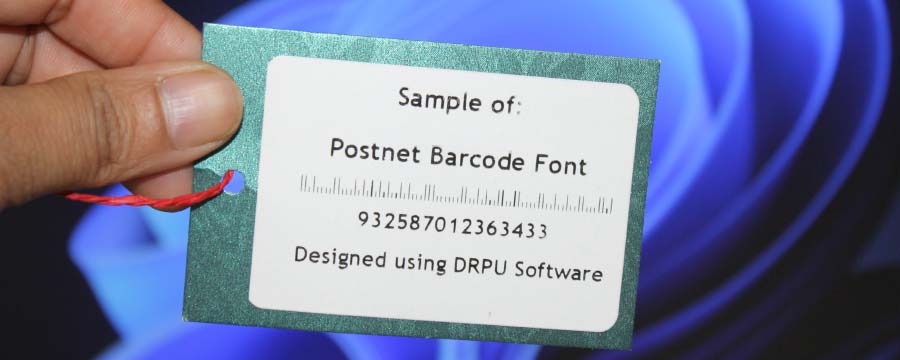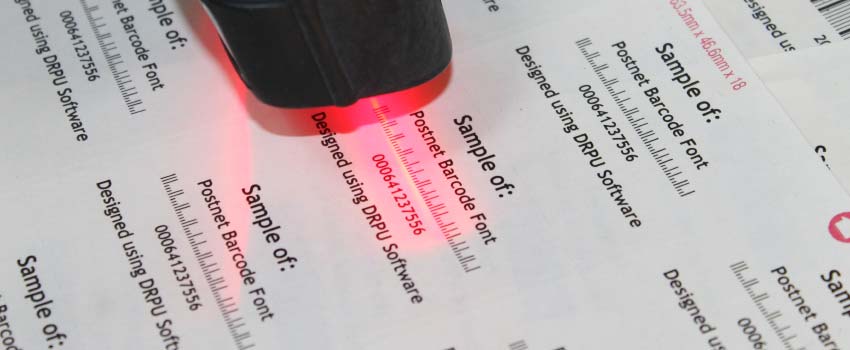Introduction Of Postnet Barcode System
Postnet barcode is a type of linear barcode that is used primarily in the United States to encode ZIP codes and other postal information. The name "Postnet" stands for "Postal Numeric Encoding Technique" and the barcode was developed by the United States Postal Service (USPS) to improve the speed, accuracy, and efficiency of mail sorting and delivery.
Postnet barcodes can be printed on a variety of surfaces including envelopes, labels, and postcards. They can be printed using a variety of printing technologies such as inkjet, laser, and thermal transfer printers

Postnet barcodes are made up of a series of tall and short bars, with each bar representing a different number. The bars are arranged in a specific pattern that is read by a barcode scanner to decode the information encoded in the barcode. The barcode can encode both ZIP codes and ZIP+4 codes, as well as other postal information such as delivery point codes.
The use of Postnet barcodes has greatly improved the efficiency of mail sorting and delivery, as the barcodes can be read and sorted by machines rather than being sorted by hand. This has reduced the amount of time and resources needed for sorting, resulting in faster and more accurate delivery of mail.
Last Updated On:
Structure Of Postnet Barcode System
-
The Postnet barcode is a type of linear barcode that is used by the United States Postal Service (USPS) to encode ZIP codes and other postal information. The structure of the Postnet barcode is relatively simple, but it is important to understand how it works in order to effectively encode and decode postal information.
-
The Postnet barcode is made up of a series of bars, each of which can be either tall or short. The bars are arranged in a specific pattern that represents a series of numbers. In the case of the Postnet barcode, each group of five bars represents a single digit in the ZIP code or other postal information being encoded.
-
The height of each bar in the Postnet barcode is determined by the value of the digit it represents. A tall bar represents a value of 1, while a short bar represents a value of 0. The five bars in each group are arranged in such a way that there are always two tall bars and three short bars.
-
The Postnet barcode also includes a "guard pattern" at the beginning and end of the barcode. This pattern consists of two tall bars, followed by two short bars, followed by two tall bars. The guard pattern helps the barcode reader distinguish the beginning and end of the barcode from the surrounding text or graphics.
Overall, the structure of the Postnet barcode is relatively simple, but it is highly effective for encoding and decoding postal information. The arrangement of the bars and the inclusion of the guard pattern and check digit make it a highly reliable and efficient way to sort and deliver mail.
Applications Of Postnet Barcode System
Postnet barcode, as a postal barcode, is widely used for mail sorting and delivery in the United States. It is commonly used by the United States Postal Service (USPS) to improve the speed and accuracy of mail processing. The following are some of the key applications of the Postnet barcode:
- 01
Mail Sorting:
Postnet barcode is widely used to sort mail according to zip code, enabling faster and more accurate delivery. Barcode contains the zip code of the destination address, which can be read by USPS sorting machines to automatically sort the mail to the correct destination.
- 02 Mail
Delivery:
Barcode helps postal workers to identify and deliver mail more quickly and efficiently. By using barcode scanners, postal workers can easily read and track the Postnet barcode to determine exact location of the mail, it easier to deliver the mail to the intended recipient.
- 03
Automation:
The Automation Postnet barcode System technology helps to automate various postal processes, including as sorting and delivery processes. Postnet barcode System leads to increased efficiency, accuracy, and cost savings for the United States Postal Service.
- 04 Tracking
and Tracing:
The barcode can be used to track and trace packages, letters, and other mail items throughout the postal system. This helps both the USPS and customers to monitor the progress of their mail and ensure that it is delivered on time.
- 05 Address
Validation:
The Address Validation barcode also allows USPS to validate the accuracy of an address. If barcode cannot be read or decoded, mail will be returned to sender, enabling them to correct errors in the address before resending the mail.
- 06 Business
Applications:
Postnet barcode can also be used by businesses to automate mail processing and delivery. For example, businesses can use Postnet barcodes to print postage labels for their mail, reducing the time and effort required for manual processing.
- 07 Discounted
Rates:
The USPS offers discounted postage rates to customers who use Postnet barcodes, incentivizing businesses to use the technology for their mail processing needs.
📜Overall, Postnet barcode is a critical technology for the USPS and businesses that rely on mail delivery. It improves the speed, accuracy, and efficiency of mail processing, leading to cost savings, improved customer satisfaction, and a more reliable postal system.
Generate Postnet Barcode System
Generating a Postnet barcode involves several steps that can be completed using software or online barcode generators.

- Determine the information to encode: Before generating the Postnet barcode, you need to decide what information you want to encode, such as a ZIP code or a delivery address.
- Convert the information into a series of numbers: The information you want to encode needs to be converted into a series of numbers that can be represented by bars of different widths. For example, a ZIP code of 90210 would be represented as the numbers 9, 0, 2, 1, and 0.
- Calculate the check digit: Postnet barcodes use a check digit to help ensure accuracy. The check digit is calculated based on the other numbers in the barcode and is added to the end of the barcode. There are several algorithms for calculating the check digit, such as the "Modulus 10" algorithm.
- Choose a barcode font: To generate the barcode, you will need to choose a barcode font that can create the necessary bar and space widths. There are several barcode fonts available, such as Postnet, Postnet 3, and Postnet 5.
- Input the data into the barcode generator: Using a software or online barcode generator, input the data and font selection to generate the Postnet barcode. Some generators may allow you to customize the size and orientation of the barcode.
- Print the barcode: Once the barcode is generated, you can print it using a printer that supports the selected font.
📜 It's important to note that the specific steps and software used for generating Postnet barcodes may vary depending on the tool or program being used. Additionally, some barcode generators may automate some of these steps, such as calculating the check digit, for you.
Limitations of Using Postnet Barcode System
Postnet barcode, like any other barcode system, has its limitations. In this section, we will discuss some of the limitations of the Postnet barcode system:
| Limited Data Capacity: | Postnet barcodes are used primarily for encoding zip codes, which consist of only 5, 9, or 11 digits. This means that the amount of information that can be encoded in a Postnet barcode is limited, making it unsuitable for applications that require more data to be encoded. |
| Poor Reading Performance: | Postnet barcodes are susceptible to reading errors due to their relatively low density and the spacing between bars. If the barcode is damaged or dirty, it can be challenging to read accurately, leading to incorrect data entry and other issues. |
| Limited Usage: | Postnet barcodes are primarily used in the United States Postal Service (USPS) for sorting and routing mail. This limited application means that Postnet barcodes may not be suitable for other industries or applications that require different types of data to be encoded. |
| Poor Compatibility: | Postnet barcodes are not as widely used as other barcode systems like UPC or Code 128, which means that many scanning devices may not be able to read them. This lack of compatibility can limit the usefulness of Postnet barcodes for certain applications. |
| Lack of Flexibility: | Postnet barcodes are designed to encode specific types of data, such as zip codes. This lack of flexibility means that they may not be suitable for applications that require different types of data to be encoded, such as product information, manufacturing dates, or serial numbers. |
| Printing Limitations: | Postnet barcodes require high-quality printing to ensure that they are readable. If the barcode is printed poorly, the barcode may not be readable, leading to data entry errors and other issues. |
| No Error Correction: | Postnet barcodes do not have error correction capabilities, which means that if a barcode is damaged or dirty, there is no way to recover the data encoded in the barcode. This limitation can lead to incorrect data entry, delivery delays, and other issues. |
| Limited Security: | Postnet barcodes do not have any security features, which means that they can be easily counterfeited or manipulated. This limitation can be problematic for applications that require high levels of security, such as pharmaceuticals, military equipment, or financial transactions. . |
In summary, while Postnet barcodes have their advantages, they also have several limitations that may make them unsuitable for certain applications.